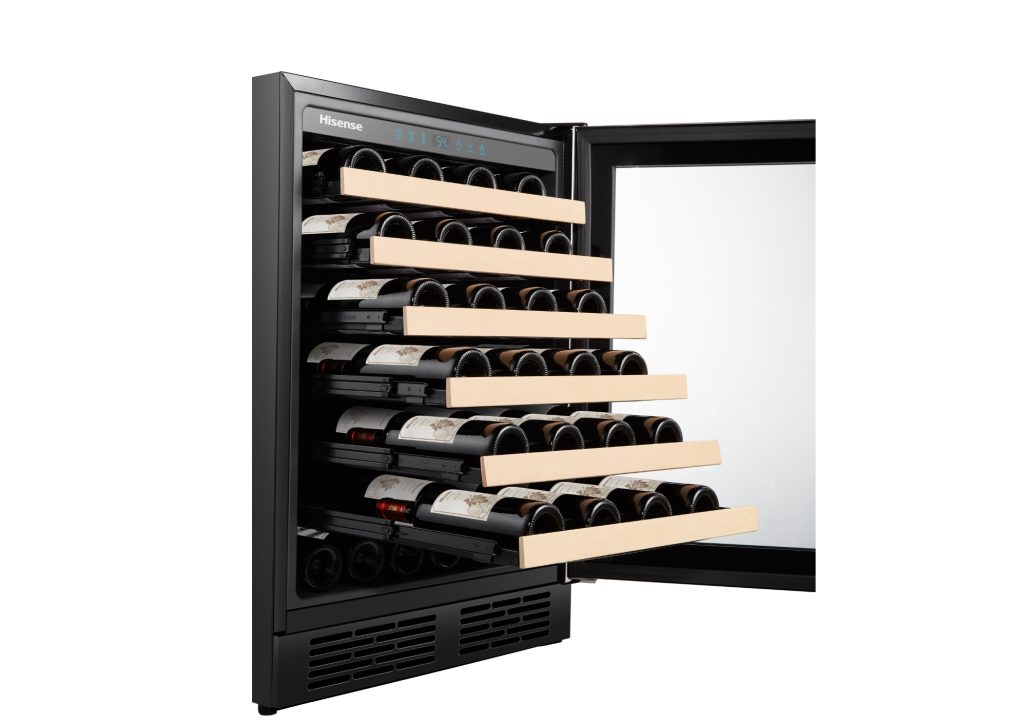
What better way to chill out than with a wine fridge? At least, that was our thinking in testing out one of the latest models from Hisense—and a growing number of consumers seem to agree.
Also known as wine coolers, the worldwide market for wine fridges is projected to rise from $5.8billion in 2022 to $25.1 billion by 2030, ‘ according to Verified Market Research.
In the U.S., the wine fridge market was valued at $326.5 million in 2020, but it is expected to grow at a compound annual growth rate of 6.4 percent through 2028, according to Grand View Research.
“The market has been increasing year-over-year,” agrees Delphie Williams, senior product manager at Hisense USA, which has been selling wine fridges in the U.S. since 2016, “and we’ve seen the consumer demand and interest in wine and specialty storage has soared, in general.”
Making the Most of Your Wine Cooler
You don’t have to be a sommelier to appreciate the benefits of a wine fridge, although it doesn’t hurt. The most important thing to know, according to Dan Sullivan, co-founder and head winemaker at Rosehall Run Vineyards, is that keeping wine at a consistent, cool temperature will optimize and preserve its flavor – so the most important features for a wine fridge, says Sullivan, are reliable temperature control and quiet operation.
In our tests of the $649 Hisense 54-Bottle Stainless Steel Wine Cooler (HWS54029SS), it met these essential criteria—and more. It represents a sweet spot in the market, appealing to those looking to protect their bottle investments and keep a variety of wines on hand for instant food pairing and impromptu entertaining. Moreover, the Hisense 54-Bottle model can be installed under a counter, or easily set up as a freestanding appliance.
Getting Hands-On with the Hisense 54-bottle Stainless Steel Wine Cooler
We chose the latter setup and found it was easily accommodated in our test kitchen. The Hisense fridge has a stainless steel clad design and stands just under 34 inches tall, which is roughly countertopheight. The fridge also has a reversible door, an essential feature for installation in any kitchen. For example, our placement was much improved by switching the door to a left-hand open, improving our cooking and entertaining feng shui. To change the door configuration took less than 30 minutes using a couple of screwdrivers.
The Hisense 54-Bottle cooler has a low-E (heat reflecting) and anti-UV translucent glass door to prevent premature aging due to light exposure, and it has six “soft close” shelves, which can accommodate standard 750 ml wine bottles, as well as thicker and heavier champagne bottles. The shelves are sturdy enough to minimize vibrations whenever you extend them to remove a bottle (an essential feature for those laying valuable vintages for several years). There is also an alarm should a curious guest leave the door to the fridge open for longer than 2 minutes.
A blue LED display allows the user to set the fridge temperature anywhere from 41 to 68 degrees Fahrenheit. We set it to 55 degrees, an ideal temperature for our red wine dominated collection. (Some more expensive models offer two temperature zones but sources, such as the Wine Spectator, point to 55 as the perfect setting.) Storage temperatures for wine in general range between 44 to 64 degrees Fahrenheit, according to Hisense’s Williams. If the temperature is too high, the bouquet and subtle flavors of the wine will be cooked out of it. Conversely, if the temperature is too low, corks can dry out, ruining the bottle’s seal and allowing for excessive air infiltration, which can turn the wine into vinegar. So, again, a consistently cool temperature is essential.
According to our vintner’s two critical wine cooler features, the Hisense 54-Bottle fridge was a winner. It easily maintained a steady temperature of 55 degrees Fahrenheit for our wine collection—even during less-than-ideal hot summer days. And it did not dominate the kitchen, proving to be a pleasantly quiet addition. Even in full-throttle cooling mode, the Hisense machine never got above 45 dB in our measurements, which is about the noise level of a quiet library. Better, when it was resting (which is most of the time), the Hisense fridge operated at a virtually silent 19 dB, essentially indistinguishablefrom even the slightest background noise.
Bottom Line:
Wine fridges range from countertop models that only hold a dozen and a half bottles and cost a couple of hundred dollars to built-in refrigerator-sized models that can provide safe harbor for a collection of a couple hundred bottles and cost upwards of $3,500. The Hisense 54-Bottle model represents something of a Goldilocks position in the market, reasonably priced so that it is accessible to most homeowners, and, according to Rosehall Run’s Dan Sullivan, large enough to hold a variety of wines for any occasion—and still stock up on wines of limited availability before prices rise.

The Hisense 54-bottle cooler’s low-E (heat reflecting) and anti-UV translucent glass door protects wine from the damaging effects of light. Courtesy of Hisense.
Hisense 54-Bottle Stainless Steel Wine Cooler Specs:
Capacity: 6 shelves; 54, 720 ml bottles,
Temperature range: 41 to 68 degrees Fahrenheit
Single zone temperature control
Size: 23.43 x 23.62 x 33.94 (W x D x H) inches
Weight: 105.6 pounds














